GHANA

Republic of Ghana
COUNTRY OVERVIEW
LOCATION AND SIZE.
The Republic of Ghana, formerly the Gold Coast, is a West African country lying on the Gulf of Guinea. It has a total border of 2,093 kilometers (1,300 miles), including 548 kilometers (341 miles) with Burkina Faso to the north, 688 kilometers (428 miles) with Côte d'Ivoire to the west, and 877 kilometers (545 miles) with Togo to the east. It has a coastline on the Gulf of Guinea, part of the Atlantic Ocean, measuring 539 kilometers (335 miles). It has an area of 239,540 square kilometers (92,486 square miles), making it about the size of the state of Oregon. Water occupies 8,520 square kilometers (3,290 square miles) of the country, primarily Lake Volta. The capital of Accra is located along the southeastern coast.
Ghana has a tropical climate, warm and comparatively dry along the southeast coast, hot and humid in the southwest, and hot and dry in the north. Its terrain is mostly low plains with a plateau in the south-central area. Its highest point is Mount Afadjato, which rises to 880 meters (2,887 feet). Lake Volta, its largest lake, is the world's largest artificial lake. Ghana has 10 regions: the Northern, Upper West, Upper East, Volta, Ashanti, Western, Eastern, Central, Brong-Ahafo, and Greater Accra.
POPULATION.
The population of Ghana was estimated at 19,533,560 in July 2000, an estimate that takes into account the impact of HIV/AIDS. It was estimated at 17,832,000 in 1996, with a density of 81 people per square kilometer (210 per square mile). About 37 percent of the population lived in urban areas and 10 percent in urban agglomerations of more than a million people. The population grew at 2.8 percent a year between 1970 and 1990, and 2.9 percent between 1990 and 1997. The fertility rate in 1997 was 4.9 children per woman.
Ghana has a young population, with more than 42 percent of the people below 15 years of age in 2000 and 55 percent in the 15-65 year bracket. Those over 65 constitute only 3 percent of the population. Life expectancy was estimated at 57 years overall, with 56 and 58 years for men and women, respectively.
The population is predominantly of African origin, with the Akan tribe comprising 44 percent of the population, the Moshi-Dagomba 16 percent, the Ewe 13 percent, the Ga-Adangbe 8 percent, the Yoruba 1.3 percent, and European and other nationalities less than 1 percent. Most people (38 percent) hold traditional beliefs, while 30 percent follow the Islamic faith, 24 percent are Christians, and 8 percent have other beliefs. English is the official language, with the other main languages being Akan, Moshi-Dagomba, Ewe, and Ga.
DEPENDENCIES
Ghana has no territories or colonies.
BIBLIOGRAPHY
Commonwealth Secretariat. "Ghana." The Commonwealth Yearbook 2000 . Birmingham: Stationery Office, 2000.
Economist Intelligence Unit. Country Profile: Ghana. London: Economist Intelligence Unit, 2001.
"Ghana." Africa South of the Sahara . London: Europa, 2000.
Ghana Embassy. <http://www.ghana-embassy.org> . AccessedSeptember 2001.
Hodd, Michael. "Ghana." The Economies of Africa. Aldershot:Dartmouth, 1991.
Leite, Sérgio Pereira, et al. Ghana: Economic Development in a Democratic Environment. Washington, D.C.: International Monetary Fund, 2000.
The Republic of Ghana. <http://www.ghana.gov.gh> . AccessedSeptember 2001.
U.S. Central Intelligence Agency. World Factbook 2000. <http://www.odci.gov/cia/publications/factbook/index.html> . Accessed August 2001.
U.S. Department of State. FY 2000 Country Commercial Guide: Ghana. <http://www.state.gov/www/about_state/business/com_guides/2000/africa/index.html> . Accessed September 2001.
Allan C.K. Mukungu
CAPITAL:
Accra.
MONETARY UNIT:
The cedi (¢). One cedi equals 100 pesewas. There are coins of 1, 2, 5, 10, 20, and 50 pesewas, and 1, 5, 10, 20, 50, and 100 cedis. There are notes of 1, 2, 5, 10, 20, 50, 100, 200, 500, and 1,000 cedis. By the end of 2001, US$1 was worth more than ¢7,500. With the decline in the value of the cedi, use of the pesewa has ceased.
CHIEF EXPORTS:
Gold, cocoa, timber, tuna, bauxite, aluminum, manganese ore, diamonds.
CHIEF IMPORTS:
Capital equipment, petroleum, foodstuffs.
GROSS DOMESTIC PRODUCT:
US$7.932 billion (1999 est.). [ CIA World Factbook lists GDP as US$35.5 billion in 1999, using the purchasing power parity conversion.]
BALANCE OF TRADE:
Exports: US$1.7 billion (f.o.b., 1999). Imports: US$2.5 billion (f.o.b., 1999).